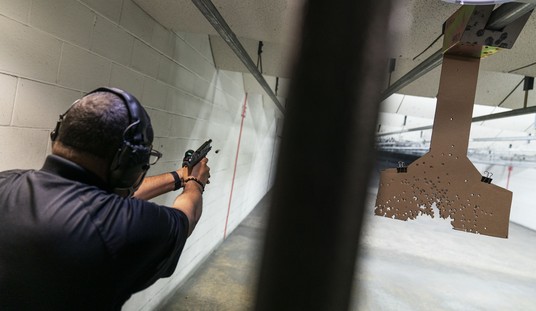I’m not a fan of firearms storage laws, which are generally unenforceable until after a tragedy has taken place and apply a one-size-fits-all mandate on gun owners, even those who don’t have kids in the home. Instead, I believe educational campaigns directed at both gun owners and kids themselves have the most impact on reducing accidents and improving public safety, and now a new study published in the Journal of the American Medical Association confirms that when kids are exposed to a simple message warning them away from unsecured firearms, it can make a huge difference.
… researchers at the Ohio State University created a randomized control trial in which 226 kids ages 8 to 12 were randomly sorted into groups. At home, one group watched a one-minute gun safety video featuring the Ohio State University police chief, while the other watched a similar video on car safety.
“Guns are not toys and are not to be played with,” Chief Kimberly Spears-McNatt states in the video. “If a child finds a real gun, they should not pick it up or move it. Instead, find an adult and tell them where it is located.”
Since the kids’ familiarity with gun safety was similar before watching the video, changes in how they behaved could be tied more closely to takeaways from the safety video.
“There’s no other experimental study on gun safety … at least that we could find,” said Bushman. “This is the only one ever conducted.”
It’s worth noting that while the message was delivered by the Ohio State University police chief, the advice she gave mirrors that of the NRA’s Eddie Eagle program, which teachers kids to “Stop, don’t touch, run away, and tell an adult” if they ever discover a gun. I don’t know why the researchers decided to use the chief instead of Eddie Eagle, though I do have my suspicions that the researchers didn’t want to do anything that could possibly portray the NRA in a positive light, but regardless of their reasoning, the results were impressive.
One week later, the kids stopped by the laboratory. In a “two-by-two” setup, kids within each group also watched clips from a PG-rated violent movie with or without guns digitally edited out. According to Bushman, the film clips were intended to act as a “trigger,” while also testing the researchers’ hypothesis that movies with guns could be a “risk factor” that makes kids more “aggressive” around firearms.
Then, in pairs, the kids were brought into another room filled with games and toys, like Jenga, foam swords, and Legos, and the adults left.
Hidden in the bottom drawer of a file cabinet in the playroom, however, were two real — but disabled — 9 mm handguns.
According to Bushman, that scenario resembles cases where adults don’t lock and secure their household firearms— they just assume that kids won’t find them.
While the children weren’t told about the guns, 96% of the kids still found them within 20 minutes. Through hidden cameras and sensors on the guns, the researchers in the next room tracked how the kids reacted.
“Kids are curious,“ said Dr. Eric Fleegler, an associate professor of pediatrics and emergency medicine at Harvard Medical School, who was not involved in the study. “Kids will find things. They have a capacity to sniff things out.”
Children who had seen the gun safety video were 28% less likely to touch the gun and held the gun for less than half the time if they did touch it. They were also over 20% less likely to pull the trigger, and those who did pulled the trigger fewer times.
“That’s an impressive intervention,” Fleegler added. “These are the types of interventions that can be delivered on a mass scale.”
The bad news is that more than half of the kids who took part in the study still picked up one of the guns, but considering their only exposure to that message of “stop, don’t touch, run away, and tell an adult” was a one-minute video they’d seen a week earlier it’s still a substantial improvement over what was seen in the control group. A more sustained campaign to drill that message into kids would likely be even more successful, and that messaging can start much earlier than the 8-to-12-year-olds who took part in the study. In fact, I’d say that education should start as early as possible, because these tragedies can involve kids who are far younger, like Serenity Robinson; a five-year-old in Columbus, Ohio who was killed when she picked up her dad’s unsecured (and illegally possessed) handgun in 2021. .
The child’s father, Antwan Robinson, 45, fell asleep next to the child with a handgun in his waistband, one of two guns that his partner and the girl’s mother, 26-year-old Breana Mathews, had illegally purchased for him because he is a convicted felon, according to prosecutors.
Both parents previously pleaded guilty to involuntary manslaughter. Antwan Robinson, also pleaded guilty to possessing a firearm illegally. Franklin County Common Pleas Judge Jaiza Page sentenced them both on Monday.
Robinson has a lengthy criminal record and has been to prison six times. Besides the involuntary manslaughter case, Robinson also had previously pleaded guilty in four cases to drug possession charges and in one case to theft.
Page sentenced him on all six cases Monday to a total indefinite prison term of 18 years to 22 years. Franklin County prosecutors had argued for at least 27 years in prison.
Mathews, bought the gun and one other for Robinson, who could not legally own them due to a past felony conviction and multiple pending felony charges against him.
Page sentenced Mathews to four years of community control, or probation. The judge also ordered Mathews as part of her community control to have no contact with Robinson, get her GED and take a parenting class. If Mathews violates her probation, she could be sent to prison for three years.
This case also shows why programs like Eddie Eagle are so important in school and even pre-school settings. While it might be nice to think that every gun-owning parent is going to deliver that message on their own, there are sadly going to be some parents like Robinson and Mathews who not only fail to secure their firearms so their inquisitive toddlers and young kids can’t reach them but fail to teach them even basic things like “don’t touch a gun.”
Franklin County prosecutors said that leading up to the shooting, Mathews and Robinson used cocaine and possibly other drugs before falling asleep in bed with their two children. Robinson got up at around 3 a.m. and asked about his guns, according to prosecutors, and Mathews told him the firearms were locked in the safe.
Robinson said he was paranoid and took a gun out from the safe and went back to sleep, according to prosecutors.
At about 8 a.m., the couple’s son was lying under the covers at the foot of the bed and Serenity was playing with Mathews’ make-up brushes on the floor next to the bed, prosecutors say.
Then Mathews said she heard a gunshot and found Serenity lying next to the bed.
Mathews said she had to wake Robinson up. Robinson told Mathews he fell asleep with the gun in the waistband of his pants and to tell police the gun was in the ottoman so he would not get in trouble, according to prosecutors.
Robinson said Serenity would point toy guns at herself while playing with them, according to court records, and Robinson would tell his daughter to point the toy guns at others, like her brother.
There’s nothing wrong with kids playing with toy guns, but when you combine that with a complete lack of education on the dangers of real firearms and a casual (or drug-fueled) disregard for keeping a loaded gun away from a child, you get tragedies like this one. The Eddie Eagle message of “stop, don’t touch, run away, tell an adult” won’t prevent every one of these terrible incidents, but it can go a long way towards keeping kids like Serenity Robinson alive even when their own parents violate the basic rules of gun safety.









Join the conversation as a VIP Member